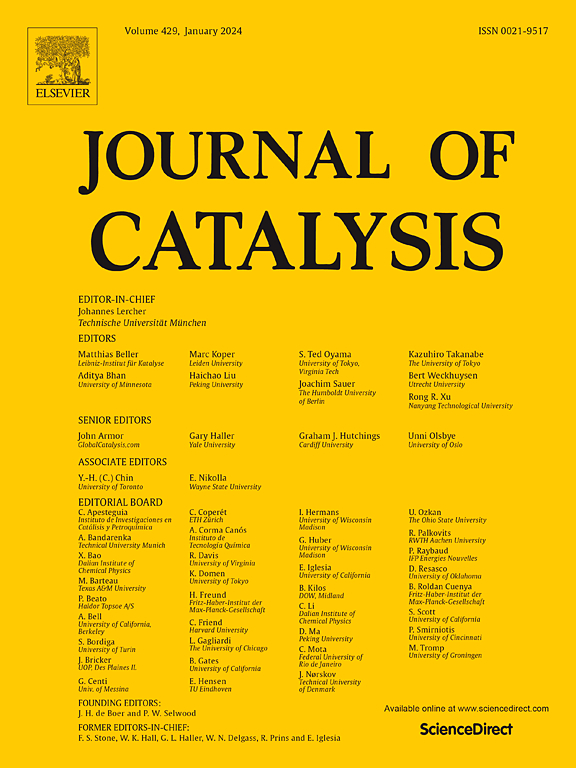Double-edged sword effect of seawater in CH4 photo-oxidation to CH3OOH: Boosting C–H activation while reducing peroxidation
IF 6.5
1区 化学
Q2 CHEMISTRY, PHYSICAL
引用次数: 0
Abstract
Realizing methane (CH4) direct converting to value-added liquid products with high selectivity still confronts huge challenges, particularly expensive catalyst costs and inferior catalyst stability. In this work, 0.6 M NaCl was firstly tentatively investigated for CH4 conversion with presence of H2O2. Then renewable, scalable and economic seawater from the Yellow Sea is directly used for catalyzing CH4 conversion to CH3OOH, and it was found that seawater increased CH3OOH production by fivefold (from 4.7–23.8 μmol h−1), while reduced CO2 production by four-fifths (from 37.0 %–7.4 %) during 8 h, demonstrating the double-edged sword effect of seawater: boosting C H activation and reducing peroxidation. In addition, no performance degradation is observed at all during 8 h reaction, proving the good stability of seawater as catalyst for CH4 conversion. Mechanism investigation indicates that in situ formed HOOCl play key roles in CH4 activation and further conversion to CH3OOH. This study highlights the effectiveness of seawater in energy conversion, which would bring huge economic benefits for the sustainable development and utilization of marine CH4.
H activation and reducing peroxidation. In addition, no performance degradation is observed at all during 8 h reaction, proving the good stability of seawater as catalyst for CH4 conversion. Mechanism investigation indicates that in situ formed HOOCl play key roles in CH4 activation and further conversion to CH3OOH. This study highlights the effectiveness of seawater in energy conversion, which would bring huge economic benefits for the sustainable development and utilization of marine CH4.

海水在CH4光氧化生成CH3OOH过程中的双刃剑效应:在促进C-H活化的同时减少过氧化作用
实现甲烷(CH4)直接转化为高选择性增值液体产品仍面临巨大挑战,特别是催化剂成本昂贵,催化剂稳定性差。本文首次初步研究了0.6 M NaCl在H2O2存在下对CH4的转化作用。结果表明,在8 h内,海水使CH4的产率提高了5倍(从4.7 μmol - 23.8 μmol h−1),同时使CO2的产率降低了5分之4(从37.0 % -7.4 %),显示了海水的双刃剑效应:促进CH活化和减少过氧化作用。此外,在8 h反应过程中没有观察到任何性能下降,证明了海水作为CH4转化催化剂的良好稳定性。机理研究表明,原位形成的HOOCl在CH4活化和进一步转化为CH3OOH中起关键作用。本研究凸显了海水能量转化的有效性,将为海洋CH4的可持续开发利用带来巨大的经济效益。
本文章由计算机程序翻译,如有差异,请以英文原文为准。
求助全文
约1分钟内获得全文
求助全文
来源期刊

Journal of Catalysis
工程技术-工程:化工
CiteScore
12.30
自引率
5.50%
发文量
447
审稿时长
31 days
期刊介绍:
The Journal of Catalysis publishes scholarly articles on both heterogeneous and homogeneous catalysis, covering a wide range of chemical transformations. These include various types of catalysis, such as those mediated by photons, plasmons, and electrons. The focus of the studies is to understand the relationship between catalytic function and the underlying chemical properties of surfaces and metal complexes.
The articles in the journal offer innovative concepts and explore the synthesis and kinetics of inorganic solids and homogeneous complexes. Furthermore, they discuss spectroscopic techniques for characterizing catalysts, investigate the interaction of probes and reacting species with catalysts, and employ theoretical methods.
The research presented in the journal should have direct relevance to the field of catalytic processes, addressing either fundamental aspects or applications of catalysis.
 求助内容:
求助内容: 应助结果提醒方式:
应助结果提醒方式:


